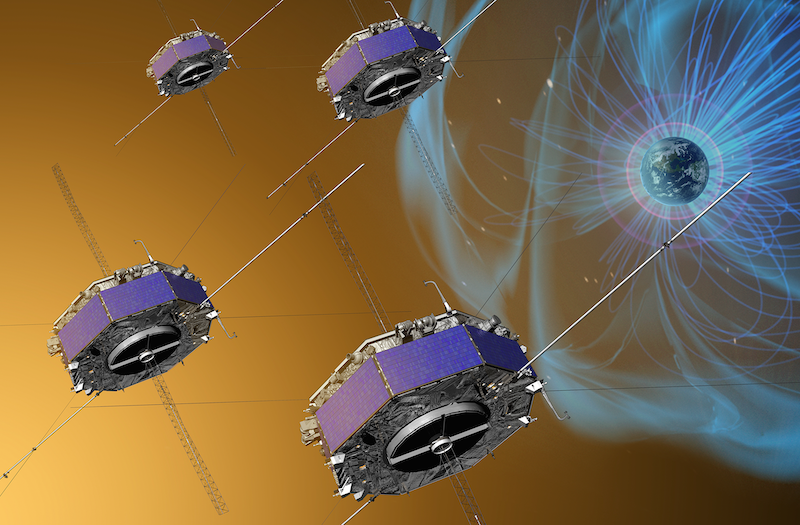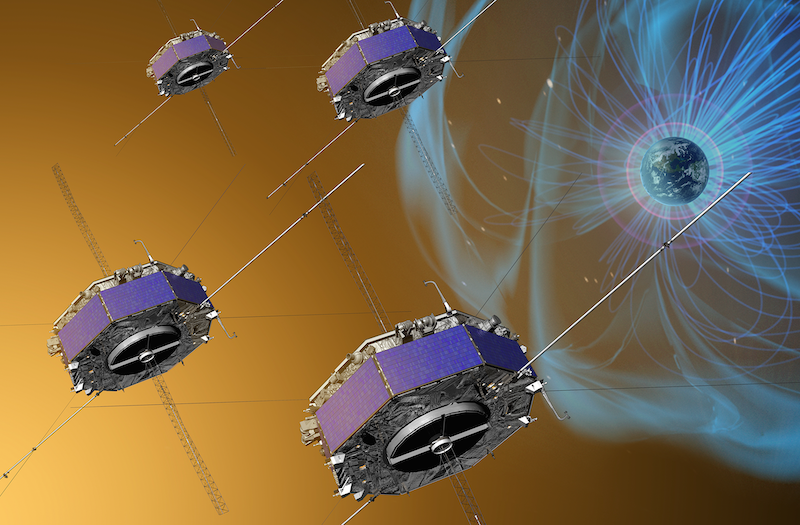How Magnetic Waves Become Heat in Earth’s Magnetosphere
Ocean currents spin off huge gyres, whose kinetic energy is transferred to ever-smaller turbulent structures until viscosity has erased velocity gradients and water molecules jiggle with thermal randomness. A similar cascade plays out in space when the solar wind slams into the magnetopause, the outer boundary of Earth’s magnetic field. The encounter launches large-scale magnetic, or Alfvén, waves whose energy ends up heating the plasma inside the magnetosphere. Here, however, the plasma is too thin for viscosity to mediate the cascade. Since 1971 researchers have progressively developed their understanding of how Alfvén waves in space plasmas generate heat. These studies later culminated in a specific hypothesis: Alfvén waves accelerate ion beams, which create small-scale acoustic waves, which generate heat. Now Xin An of UCLA and his collaborators have found direct evidence of that proposed mechanism [1]. What’s more, the mechanism is likely at work in the solar wind and other space plasmas.
Laboratory-scale experiments struggle to capture the dynamics of rotating plasmas, and real-world observations are even more scarce. The observations that An and his collaborators analyzed were made in 2015 by the four-spacecraft Magnetospheric Multiscale (MMS) mission. Launched that year, the MMS was designed to study magnetic reconnection, a process in which the topology of magnetic-field lines is violently transformed. The field rearrangements wrought by reconnection can be large, on the scale of the huge loops that sprout from the Sun’s photosphere. But the events that initiate reconnection take place in a much smaller region where neighboring field lines meet, the X-line. The four spacecraft of MMS can fly in a configuration in which all of them witness the large-scale topological transformation while one of them could happen to fly through the X-line—a place where no spacecraft had deliberately been sent before.
On September 8, 2015, the orbits of the MMS spacecraft took them through the magnetopause on the dusk side of Earth. They were far enough apart that together they could detect the passage of a large-scale Alfvén wave, while each of them could individually detect the motion of ions in the surrounding plasma. An and his collaborators later realized that these observations could be used to test the theory that ion beams and the acoustic waves that they generate mediate the conversion of Alfvén-wave energy to heat.
Data from the various instruments aboard the MMS spacecraft show signatures from all three factors that drive the energy cascade: Alfvén waves and ion beams, both of which have length scales of about 2000 km, and acoustic waves, which have length scales of 50–1500 m. Crucially, the instruments also recorded connections between the processes. The Alfvén waves’ magnetic-pressure variations were in sync with fluctuations in ion density and the local electric field, while the ion beams’ speeds matched those of either the local Alfvén waves or the acoustic waves.
In situ spacecraft measurements are like taking snapshots of an unfolding process. Although the MMS observations lasted 2.4 hours, they did not amount to a full movie. To boost their confidence that the apparent connections they observed were real, the researchers performed simulations using the US National Center for Atmospheric Research’s supercomputer, Derecho. The simulations, which spent 4000 CPU hours to track 0.5 billion particles through 400,000 time steps, matched the observations.
“These results offer new, detailed insights into the complex, multiscale tangle of dynamical processes that regulate the energetics and structure of space and astrophysical plasmas,” says François Rincon, who studies plasmas at the Midi-Pyrenees Observatory in France.
An and his colleagues have since identified instances of the energy-transfer mechanism in other MMS data. The conditions that enable the mechanism could be more prevalent in the solar wind. The researchers plan to extend their investigation using data from the Parker Solar Probe and the Solar Orbiter. “These additional observations will help us better understand how widespread this energy-transfer mechanism is in space plasmas,” An says.
–Charles Day
Charles Day is a Senior Editor for Physics Magazine.
References
- X. An et al., “Cross-scale energy transfer from fluid-scale Alfvén waves to kinetic-scale ion acoustic waves in the Earth’s magnetopause boundary layer,” Phys. Rev. Lett. 133, 225201 (2024).





